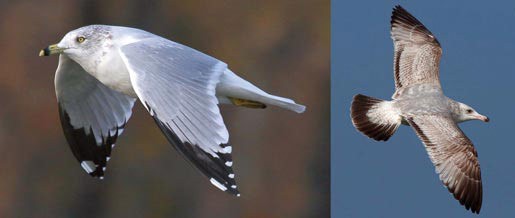The herring gull, one of our most cosmopolitan bird species, thrives in picnic areas or parking lots, at farms or fast-food joints, at sea or in sewage lagoons. The ivory gull, the embodiment of white, breeds as far north as any bird. And across the planet, not far from the Antarctic Peninsula, the kelp gull can gouge and eat blubber from the backs of surfacing southern right whales.
Gulls are nothing if not resourceful. About 50 species inhabit the planet. Here in the Northeast, we are fortunate to find at least a dozen, including rarities from the Arctic, Europe, or Asia. So perhaps you may be asking yourself, “Is this guy actually trying to get me to watch gulls?” Warblers? Sure. Thrushes? Fine. Sparrows? Maybe. But gulls?
Yeah, gulls.
Hey, this is winter, after all. The warblers and thrushes and sparrows have left us like lovers scorned. Silent is the dawn chorus. Faded are the sparks of songbird color. Gulls, gliding in on frosty winds, stoic out on the ice, beckon like sparkling snow on a sunny day. (By the way, please do not call them seagulls; it’s an inaccurate term for gulls, even for those spending much of their lives at sea.)
Although many species have adapted to human habitats, their ability to exploit seas, freshwater coastal zones, and inland sites make gulls an evolutionary success story. They are widespread and peripatetic, and therefore relatively secure on planet Earth. Gulls are sociable, nesting and foraging in groups. They’re also smart. Our rather common herring gull, for example, has been reported to drop pieces of bread in water as bait for catching fish. It’s one thing for a gull to drop a mussel on a rock to crack it open; it’s a bigger deal when a bird uses easy food as a tool to secure a better meal.
Because gulls are fairly tame, they are easy to observe. But even though they are elegant in flight many birders avoid gulls, or wish they would just fly away. One reason for the “Lariphobia” (gulls belong to the family Laridae) is that gulls present some of the greatest identification challenges in birding. Many species take three or four years to reach their definitive adult plumage, which is usually a tidy combination of white, gray, and black. During each of those youthful years, however, gulls show stages of brown mottling, which also varies seasonally from summer to winter. The result is that some gull species can show eight different plumages. To the novice, it’s like identifying snowflakes. But fear not: here is some basic advice for the bewildered gull-watcher.
First is “age before beauty.” If you’re new to this game, begin by watching the adults, which show no brown or gray mottling other than streaks on the head in winter. The shape, color, and markings on the bill also help in identification. So does leg color. Relative overall size can be useful, as can head shape.
Also, know that you will be less likely to discover the rare gull unless you first recognize the common species. So here’s what you must know about adult plumages of the Northeast’s three most common gulls.
• The herring gull has a clean white body and tail, a uniform gray upper-side, black wingtips with white spots, an orange dot on a yellow bill, and pink legs.
• The ring-billed gull looks like a smaller version of the herring gull, except that it has (fittingly) a black ring around its small yellow bill, and its legs are yellow.
• The great black-backed gull – the largest gull in the world – looks a bit like a herring gull, except that its upper-side is black (not gray like most other gulls).
From here your birdwatching will expand through a winter of possibilities. Gulls offer some of the best evidence that nature is a lifelong learning experience. And if you happen to bump into a hungry kelp gull, keep your shirt on and watch your back.


